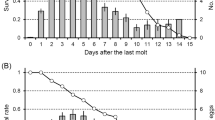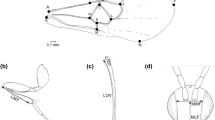Abstract
Developmental success on 47 species of plant and reproductive compatibility were studied for four strains of the European red mite,Panonychus ulmi (Koch), collected from dwarf bamboo, elm and apple trees. The host range was variable in those strains and there was no plant species on which all four strains were able to reach maturity.
Intra-populational crosses in the dwarf-bamboo strain and the two apple strains of mites, as well as crosses between the two apple strains, gave both female and male progeny. Inter-populational crosses between the dwarf-bamboo and apple strains produced only male progeny, as in the case where females of each strain were kept virgin, indicating that these two were reproductively incompatible and had an arrhenotokous reproductive system. When females of the elm strain were crossed with males of the elm, dwarf-bamboo or apple strain, no males were produced, as in the case for virgin females of the elm strain which had a thelytokous reproductive system. It is thus concluded that the strains derived from different host species were reproductively incompatible with one another.
Similar content being viewed by others
References
Blair, C.A. and Groves, J.R., 1952. Biology of the fruit tree red spider miteMetatetranychus ulmi (Koch) in south-east England. J. Hortic. Sci., 27: 14–43.
Diehl, S.R. and Bush, G.L., 1984. An evolutionary and applied perspective of insect biotypes. Annu. Rev. Entomol., 29: 471–504.
Ehara, S. and Gotoh, T., 1987. Notes on the genusSasanychus Ehara, new status, with description of a new species from Hokkaido (Acarina, Tetranychidae). Zool. Sci., 4: 375–378.
Ehara, S. and Shinkaji, N., 1975. An Introduction to Agricultural Acarology. Zenkoku Noson Kyoiku Kyokai, Tokyo, 328 pp. (in Japanese).
Gotoh, T., 1986. Reproductive isolation between the two forms ofPanonychus akitatus Ehara (Acarina: Tetranychidae). Exp. Appl. Acarol., 2: 153–160.
Gotoh, T., 1987. Intraleaf distribution ofPanonychus ulmi (Koch) (Acarina: Tetranychidae) on dwarf bamboo. Appl. Entomol. Zool., 22: 248–258.
Gutierrez, J., Helle, W. and Bolland, H.R., 1970. Étude cytogenetique et reflexions phylogenetiques sur la famille des Tetranychidae Donnadieu. Acarologia, 12: 732–751.
Helle, W. and Bolland, H.R., 1967. Karyotypes and sex-determination in spider mites (Tetranychidae). Genetica, 38: 43–53.
Helle, W. and Pijnacker, L.P., 1985. Parthenogenesis, chromosomes and sex. In: W. Helle and M.W. Sabelis (Editors), Spider Mites, Their Biology, Natural Enemies and Control. Elsevier, Amsterdam, Vol. A, pp. 129–139.
Jeppson, L.R., Keifer, H.H. and Baker, E.W., 1975. Mites Injurious to Economic Plants. University of California Press, Berkeley, 614 pp.
Kurokawa, S., 1988. A list of vascular plants in the Tsukuba Botanical Garden, 1988. Ann. Tsukuba Bot. Gard., 7: 1–120 (in Japanese).
Maekawa, F., Hara, H. and Tuyama, T., 1977. Makino's New Illustrated Flora of Japan. Hokuryukan, Tokyo, 1060 pp. (in Japanese).
Morimoto, N. and Takafuji, A., 1983. Comparison of diapause attributes and host preference among three populations of the citrus red mite,Panonychus citri (McGregor) in the southern part of Okayama Prefecture, Japan. Jpn. J. Appl. Entomol. Zool., 27: 224–228 (in Japanese, with English summary).
Moriyama, S. and Mori, H., 1977. Mites. In: Y. Kitazawa (Editor), Ecosystem Analysis of the Subalpine Coniferous Forest of the Shigayama IBP Area, Central Japan. University of Tokyo Press, Tokyo, pp. 54–61.
Osakabe, Mh., 1987. Esterase activities and developmental success of the citrus red mite,Panonychus citri (McGregor) (Acarina: Tetranychidae), on several plants. Appl. Entomol. Zool., 22: 35–44.
Pashley, D.P., 1986. Host-associated genetic differentiation in fall armyworm (Lepidoptera: Noctuidae): a sibling species complex? Ann. Entomol. Soc. Am., 79: 898–904.
Pashley, D.P. and Martin, J.A., 1987. Reproductive incompatibility between host strains of the fall armyworm (Lepidoptera: Noctuidae). Ann. Entomol. Soc. Am., 80: 731–733.
Saito, Y. and Takahashi, K., 1982. Study on variation ofSchizotetranychus celarius (Banks). II. Comparison of mode of life between two sympatric forms (Acarina: Tetranychidae). Jpn. J. Ecol., 32: 69–78 (in Japanese, with English summary).
Shinkaji, N., 1961. On the diapause of the citrus red mite,Panonychus citri (McGregor). Bull. Hortic. Stn. Nat. Tokai-Kinki Agric. Exp. Stn., 6: 64–76 (in Japanese, with English summary).
Shinkaji, N., 1969. Studies on the peach pyralid moth,Dichocrocis punctiferalis Guenee (Lepidoptera: Pyralidae). I. Seasonal development with special references to the difference between the fruit tree type and the conifer type. Bull. Hortic. Res. Stn., Ser. A, 8: 155–208 (in Japanese, with English summary).
Suzuki, S., 1978. Index to Japanese Bambusaceae. Gakken, Tokyo, 384 pp. (in Japanese and English).
Takafuji, A. and Fujimoto, H., 1985. Reproductive compatibility between populations of the citrus red mite,Panonychus citri (McGregor) (Acarina: Tetranychidae). Res. Popul. Ecol., 27: 361–372.
Uchida, M., 1982. Ecological studies on the abundance and diapause of spider mites and the damage caused by the spider mites in Japanese pear orchards. Tottori Fruit Tree Exp. Stn., Spec. Bull., 2: 1–63 (in Japanese, with English summary).
Author information
Authors and Affiliations
Rights and permissions
About this article
Cite this article
Gotoh, T., Noguchi, O. Developmental success and reproductive incompatibility among populations of the European red mite,Panonychus ulmi (Acari: Tetranychidae). Exp Appl Acarol 10, 157–165 (1990). https://doi.org/10.1007/BF01194091
Accepted:
Issue Date:
DOI: https://doi.org/10.1007/BF01194091




